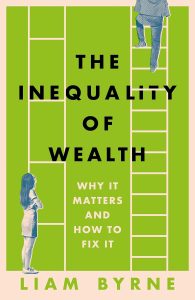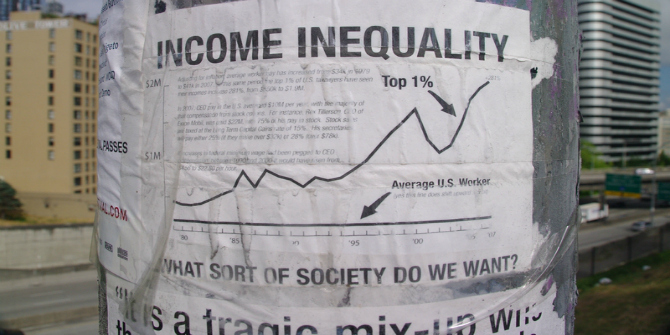In The Inequality of Wealth: Why it Matters and How to Fix it, Liam Byrne examines the UK’s deep-seated inequality which has channelled wealth away from ordinary people (disproportionately youth and minority groups) and into the hands of the super-rich. While the solutions Byrne presents – from boosting wages to implementing an annual wealth tax – are not new, the book synthesises them into a coherent strategy for tackling this critical problem, writes Vamika Goel.
Liam Byrne launched the book at an LSE event in February 2024: watch it back on YouTube.
The Inequality of Wealth: Why it Matters and How to Fix it. Liam Byrne. Bloomsbury. 2024.
 Wealth inequality, a pressing issue of our times, reinforces all other forms of inequality, from social and political to ecological inequality. In The Inequality of Wealth, Liam Byrne recognises this fact and emphasises the need to move away from a narrow focus on addressing income inequality. He reaffirms the need to deal with wealth inequality and address the issue of inequality holistically.
Wealth inequality, a pressing issue of our times, reinforces all other forms of inequality, from social and political to ecological inequality. In The Inequality of Wealth, Liam Byrne recognises this fact and emphasises the need to move away from a narrow focus on addressing income inequality. He reaffirms the need to deal with wealth inequality and address the issue of inequality holistically.
The book adopts a multi-pronged approach to addressing wealth inequality in the UK. It is divided into three parts. The first part discusses the extent of wealth inequality and how it affects democracy and damages meritocracy. The second part discusses the emergence of neoliberalism which has promoted unequal distribution of resources, while the third part proposes corrective measures to reverse wealth inequality.
According to Forbes, the world’s billionaires have doubled from 1001 to 2640 during 2010 and 2022, adding around £7.1 trillion to their combined wealth.
The first chapter reflects on the exorbitant surge in wealth globally during the past decade, primarily enjoyed by the world’s super-rich. According to Forbes, the world’s billionaires have doubled from 1001 to 2640 during 2010 and 2022, adding around £7.1 trillion to their combined wealth. In the UK, wealth disparity has risen, with the top 10 per cent holding about half of the wealth while the bottom 50 per cent held only 5 per cent in Great Britain in 2018-20, as per the Wealth and Assets Survey. Byrne claims that this inequality has only been exacerbated in recent years. Despite adverse negative shocks like the COVID-19 pandemic, austerity, and Brexit, about £87 billion has been added to UK billionaire’s wealth during 2021 and 2023.
The book highlights that youth have borne the brunt of this widening wealth disparity. According to data from Office of National Statistics (ONS), those aged between twenty and forty, hold only eight per cent of Britain’s total wealth. In contrast, people aged between fifty-five and seventy-five owned over half of Britain’s total wealth in 2018-20. Their prospects of wealth accumulation have further declined with a squeeze in wages and booming asset prices as a result of quantitative easing. Byrne contends that this has made Britain an “inheritocracy” wherein a person’s parental wealth, social connections and the ability to access good education are more important determinants of wealth than hard work and talent.
Those aged between twenty and forty, hold only eight per cent of Britain’s total wealth.
The second part of the book explores the spread of the idea of neoliberalism since the 1980s, that helped sustain and flourish wealth inequality. Neoliberalism promoted the idea of market supremacism and reduced the role of the state. The later chapters in this section engage in depth with rent-seeking behaviour by corporates and the increase in market concentration via mergers and acquisitions.
The third part of the book proposes corrective measures needed to reverse wealth inequality. The book contends that the starting point of arresting wealth disparity is to boost labour incomes by creating well-paying, knowledge-intensive jobs. Byrne does not elucidate as to what he means by these knowledge-intensive jobs. Usually, knowledge-intensive jobs are those in financial services, high-tech manufacturing, health, telecommunications, and education. Byrne argues that earnings in knowledge-intensive jobs are about 30 per cent higher than average pay. However, these jobs accounted for only about a fifth of all jobs and a quarter of economic output in 2021. Hence, promoting such jobs will significantly raise workers’ earnings.
The author maintains that knowledge-intensive jobs can be generated by giving impetus to state-backed research and development (R&D) spending and innovation. He draws attention to low growth in R&D spending in UK at per cent between 2000 and 2020, when global R&D spending has more than tripled to £1.9 trillion. However, there are some fundamental concerns regarding the effectiveness of such reforms in curbing inequality and ensuring social mobility.
People of Black African ethnicity are disproportionately employed in caring, leisure and other service-based occupations. They also hold about eight times less wealth than their white counterparts.
First, knowledge-intensive jobs are highly capital-intensive and high R&D spending may not generate enough jobs or may make some existing jobs redundant. The author has not substantiated his claim with any empirical evidence. Second, it’s possible that innovation spending and jobs perpetuate the existing social and regional inequalities. In the UK, about half of all knowledge-intensive jobs are generated in just two regions: London and the South East. To address regional disparities, Byrne suggests setting up regional banks, training skills and integration at the regional level, and promoting Research and Development (R&D) in small and medium enterprises (SMEs) via tax credits and innovation vouchers. However, no mechanism is laid out with which to tackle social inequality. People of Black African ethnicity are disproportionately employed in caring, leisure and other service-based occupations. They also hold about eight times less wealth than their white counterparts. It seems likely that new knowledge-intensive jobs would disproportionately benefit people of white ethnicity from wealthy backgrounds with connections and access to good education.
Another measure specified to boost labour incomes is to shift towards a system that adequately rewards workers for their services, that is, a system of “civic capitalism”, as coined by Colin Hay. Byrne alleges that one step to ensure this is to create an in-built mechanism that ensures workers’ savings are channelled into companies that adopt sustainable and labour-friendly practices. One of the ways to achieve this is to require the National Employment Savings Trust (NEST) sets up guidelines and benchmarks for social and environmental goals for the companies in which it invests. In this way, Byrne has adopted an indirect approach to workers’ welfare, as opposed to a direct approach through promoting trade unionisation among workers, which in the UK has fallen from 32.4 per cent in 1995 to 22.3 per cent in 2022 . This would enhance workers’ bargaining power to increase their wages and secure better benefits and security.
Apart from boosting workers’ wages, Byrne underscores the need to create wealth for all, ie, a wealth-owning democracy. Inspired by Michael Sherraden’s idea of “asset-based welfare” and Individual Development Accounts, Byrne proposes to create a Universal Savings Account that enables every individual to accumulate both pension and human capital. He advocates that a Universal Savings Account can be created by merging Auto-enrolment pension accounts, Lifetime Individual Savings Accounts (LISAs) and the Help to Save scheme. Re-iterating the proposals from the pioneering studies by the Institute of Fiscal Studies and the Resolution Foundation, Byrne proposes to expand the coverage of the auto-enrolment pension scheme to low-income earners, the self-employed and youth aged between 16 and 18, to increase savings rates and to reduce withdrawal limits from the pension fund.
In the last chapter, Byrne emphasises the enlargement of net household wealth relative to GDP from 435 per cent in 2000 to about 700 per cent by 2017, without any commensurate change in wealth-related taxes to GDP share. This has created a problem of unequal taxation across income groups, which, he states, must be rectified. To do this, he endorses Arun Advani, Alex Cobham and James Meade’s proposals of introducing an annual wealth tax.
Byrne attempts to encapsulate an existing range of ideas for reform pertaining to diverse domains like state-backed institutions, corporate law restructuring, social security and tax reforms.
Overall, the book presents a coherent strategy to reverse wealth disparity and build a wealth-owning democracy through a guiding principle of delivering social justice and promoting equality. The remedies for reversing wealth inequality offered in the book are not new; rather, Byrne attempts to encapsulate an existing range of ideas for reform pertaining to diverse domains like state-backed institutions, corporate law restructuring, social security and tax reforms. The pathway for the acceptance and adoption of all these reforms is no mean feat; it would entail a shift from a narrow focus on profit-maximisation towards holistic attempts to adequately reward workers for their services and improve their wellbeing.
Note: This post gives the views of the author, and not the position of the LSE Review of Books blog, or of the London School of Economics and Political Science.
Image credit: Cagkan Sayin on Shutterstock.








1 Comments